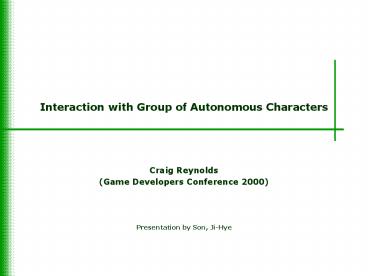Interaction with Group of Autonomous Characters - PowerPoint PPT Presentation
1 / 16
Title:
Interaction with Group of Autonomous Characters
Description:
The demo runs on a PlayStation2 at an update rate of 60 fields per second. 280 birds ... PlayStation2 hardware, CDS software, simple shading models ... – PowerPoint PPT presentation
Number of Views:155
Avg rating:3.0/5.0
Title: Interaction with Group of Autonomous Characters
1
Interaction with Group of Autonomous Characters
- Craig Reynolds
- (Game Developers Conference 2000)
- Presentation by Son, Ji-Hye
2
Outline
- Introduction
- Related Work
- Behavioral Models
- Case study Pigeons in the Park
- Reacting to the User
- Realtime Performance
- Conclusions
3
Introduction
- Real world
- Busy, crowded
- Game world
- Static, empty
- Large numbers of autonomous characters
- Coordinate with or react to each other, the
environment and users avatar - Three key concepts
- Behavioral models
- Spatial data structure
- The techniques used to drive animation from
behavior models
4
Related Work
- The historical trend
- Very simplistic autonomous characters
- Nimble reactive characters Reyn99
- Characters which can learnGran98,
reasonLair00, and planFung99 - The games
- SimCity, SimAnt, SimTower, The Sims
- Lemmings, Populous
- Myth, Warcraft
5
Behavioral Models (1/2)
- The behavior model
- Drives autonomous characters
- position, velocity, orientation, and visual
appearance - Maps the characters environment into character
actions. - The characters environment
- Virtual world (external environment)
- Memory or metal processes (internal environment)
- Simple physical model
- A point mass with velocity and a local frame of
reference - A finite steering force
- The local coordinate system
6
Behavioral models (2/2)
- Multiple distinct behavioral states
- Transitions are triggered by changes in the
characters environment. - FSM (finite state machine)
- Ex) a fighter jet
7
Case study Pigeons in the park (1/3)
- Pigeons in the park
- User/player interaction
- Real-time
- A large group of simple autonomous character
- The virtual world
- The birds
- A radio controlled car
- An undulating terrain
- An invisible spherical obstacle
- The pigeons
- The Boids model Reyn87
- Steering behaviors Reyn99
8
Case study Pigeons in the park (2/3)
- A nearby car or the hand clap causes the birds to
take flight. - The urge to take off is contagious.
- Sensing the nearby birds who have recently taken
off - A bird land again.
- The annoyance value
- gets ratcheted up when a bird gets startled
- Then slowly decays over time
9
Case study Pigeons in the park (3/3)
- Animation for the birds
- Behavioral parameters
- Position, orientation, walking/flying flag, rate
of change of the glide slope - A set of pre-animated cycles
- Walking, Flying, Gliding, WingFold
- The demo runs on a PlayStation2 at an update rate
of 60 fields per second - 280 birds
- 55000 triangles
10
Reacting to the User (1/2)
- Respond to the user in two different ways
- Discrete reaction
- Continuous reaction
- A neighborhood around the car
- Depends on the cars position and velocity.
- Shape
- a half circle behind the car
- a half ellipse in front of the car.
11
Reacting to the User (2/2)
- The neighborhood
- Move away
- Take off
- In the move-away zone
- Move away from both the car and its current path.
12
Realtime Performance
- Three main sources of computational load
- Rendering
- Thinking
- Locality queries
- Rendering
- Rendering the 3D shaded, textured, scene, in
perspective. - PlayStation2 hardware, CDS software, simple
shading models - 15 to 20 of each display cycle (one-sixtieth of
a second)
13
Realtime Performance Thinking
- Thinking
- The time taken for each of the autonomous
characters to think - The cost is multiplied by the number of
characters. - O(n)
- To reduce the cost
- Decouple the behavioral computation from the
simulation rate - a low rate 10Hz (one sixth of the animation
rate) - The thinking about obstacle avoidance is done
at a higher rate (30Hz)
14
Realtime Performance Locality queries (1/2)
- Locality queries
- The cost of doing locality queries between
characters - An interacting particle system
- N comparisons for each particle
- Complexity of O(n2)
- To reduce the cost
- To store the characters in spatial data structure
- To keep the characters pre-sorted based on
their location in space
15
Realtime Performance Locality queries (2/2)
- The bin-lattice spatial data structure
- Divide a space into a collection of smaller boxes
(bin) - A locality query
- performed by specifying a sphere and a function
- O(n)
16
Conclusions
- A realtime system with a large group of
autonomous characters - move themselves around
- React to each other, to obstacles, and the users
avatar - Realtime performance
- By decoupling the behavioral model from the
graphical update rate - By the use of a lattice-bin spatial subdivision
technique































